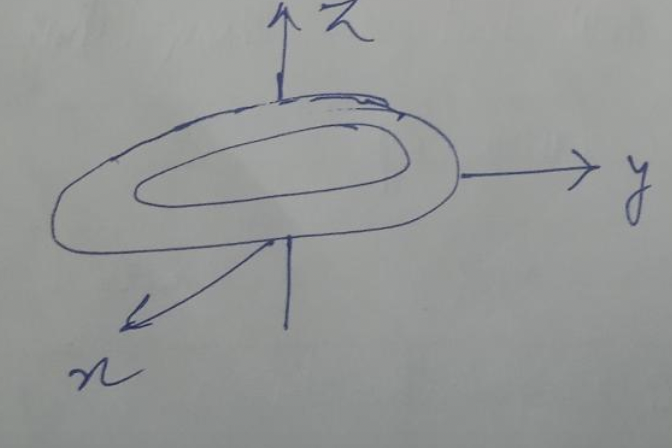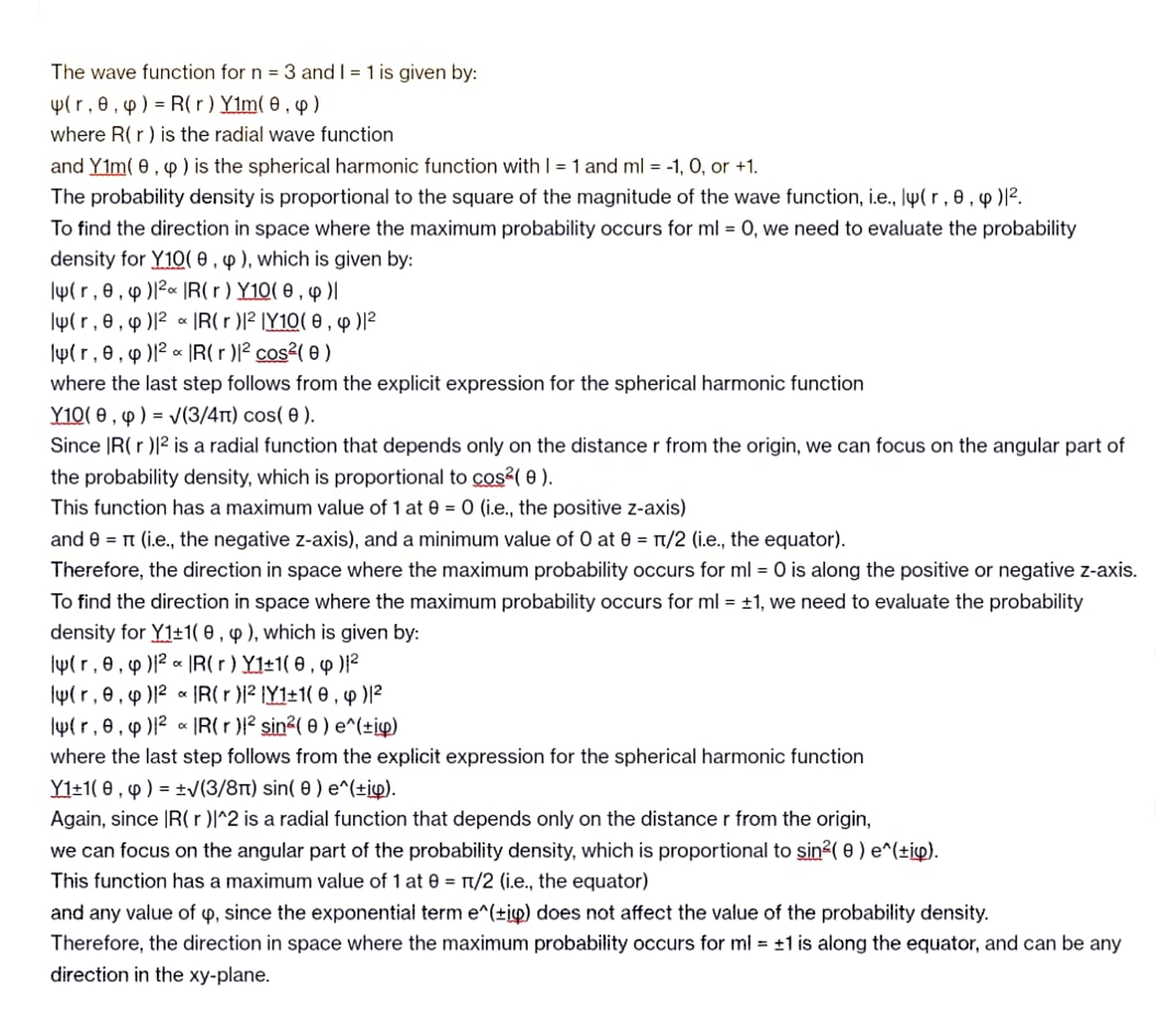Answered step by step
Verified Expert Solution
Question
1 Approved Answer
For the n = 3 and l = 1 wave function find the direction in space when the maximum probability occurs for ml = 0
For the n = 3 and l = 1 wave function find the direction in space when the maximum probability occurs for ml = 0 and ml = 1?

 \fThe wave function for n = 3 and I = 1 is given by: 4(r , 8, 4) = R(r ) Yim( 0 , 4) where R( r ) is the radial wave function and Yim( 0 , 4 ) is the spherical harmonic function with I = 1 and ml = -1, 0, or +1. The probability density is proportional to the square of the magnitude of the wave function, i.e., ly(r , e , ( )|2. To find the direction in space where the maximum probability occurs for ml = 0, we need to evaluate the probability density for Y10( e , 4 ), which is given by: ly( r, e, )12x |R(r ) Y10( e , 4 )1 ly( r , e, p)12 a |R(r ) 12 1Y10( 8, 4 )12 ly( r, e , )12 x |R(r )12 cos2( e ) where the last step follows from the explicit expression for the spherical harmonic function Y10( 0 , 4 ) = V(3/41) cos( 8 ). Since IR( r )12 is a radial function that depends only on the distance r from the origin, we can focus on the angular part of the probability density, which is proportional to cos ( 0 ). This function has a maximum value of 1 at 0 = 0 (i.e., the positive z-axis) and 8 = It (i.e., the negative z-axis), and a minimum value of O at 0 = It/2 (i.e., the equator). Therefore, the direction in space where the maximum probability occurs for ml = 0 is along the positive or negative z-axis. To find the direction in space where the maximum probability occurs for ml = #1, we need to evaluate the probability density for Y1+1( 0 , 4 ), which is given by: lu( r , e, p )12 * \\R(r ) Y1=1( 0 , 4 )12 ly(r , e, ()12 * \\R(r ) 12 1Y1=1( 0 , 4)12 |(r , 0, ()12 x |R(r )12 sin2( 0 ) e"(tipp) where the last step follows from the explicit expression for the spherical harmonic function Y1=1( 0 , 4 ) = =V(3/8n1) sin( 0 ) e"(tipp). Again, since |R( r )|^2 is a radial function that depends only on the distance r from the origin, we can focus on the angular part of the probability density, which is proportional to sin=( e ) e"(tip). This function has a maximum value of 1 at 0 = It/2 (i.e., the equator) and any value of 4, since the exponential term e"(tip) does not affect the value of the probability density. Therefore, the direction in space where the maximum probability occurs for ml = +1 is along the equator, and can be any direction in the xy-plane
\fThe wave function for n = 3 and I = 1 is given by: 4(r , 8, 4) = R(r ) Yim( 0 , 4) where R( r ) is the radial wave function and Yim( 0 , 4 ) is the spherical harmonic function with I = 1 and ml = -1, 0, or +1. The probability density is proportional to the square of the magnitude of the wave function, i.e., ly(r , e , ( )|2. To find the direction in space where the maximum probability occurs for ml = 0, we need to evaluate the probability density for Y10( e , 4 ), which is given by: ly( r, e, )12x |R(r ) Y10( e , 4 )1 ly( r , e, p)12 a |R(r ) 12 1Y10( 8, 4 )12 ly( r, e , )12 x |R(r )12 cos2( e ) where the last step follows from the explicit expression for the spherical harmonic function Y10( 0 , 4 ) = V(3/41) cos( 8 ). Since IR( r )12 is a radial function that depends only on the distance r from the origin, we can focus on the angular part of the probability density, which is proportional to cos ( 0 ). This function has a maximum value of 1 at 0 = 0 (i.e., the positive z-axis) and 8 = It (i.e., the negative z-axis), and a minimum value of O at 0 = It/2 (i.e., the equator). Therefore, the direction in space where the maximum probability occurs for ml = 0 is along the positive or negative z-axis. To find the direction in space where the maximum probability occurs for ml = #1, we need to evaluate the probability density for Y1+1( 0 , 4 ), which is given by: lu( r , e, p )12 * \\R(r ) Y1=1( 0 , 4 )12 ly(r , e, ()12 * \\R(r ) 12 1Y1=1( 0 , 4)12 |(r , 0, ()12 x |R(r )12 sin2( 0 ) e"(tipp) where the last step follows from the explicit expression for the spherical harmonic function Y1=1( 0 , 4 ) = =V(3/8n1) sin( 0 ) e"(tipp). Again, since |R( r )|^2 is a radial function that depends only on the distance r from the origin, we can focus on the angular part of the probability density, which is proportional to sin=( e ) e"(tip). This function has a maximum value of 1 at 0 = It/2 (i.e., the equator) and any value of 4, since the exponential term e"(tip) does not affect the value of the probability density. Therefore, the direction in space where the maximum probability occurs for ml = +1 is along the equator, and can be any direction in the xy-plane Step by Step Solution
There are 3 Steps involved in it
Step: 1

Get Instant Access to Expert-Tailored Solutions
See step-by-step solutions with expert insights and AI powered tools for academic success
Step: 2

Step: 3

Ace Your Homework with AI
Get the answers you need in no time with our AI-driven, step-by-step assistance
Get Started


